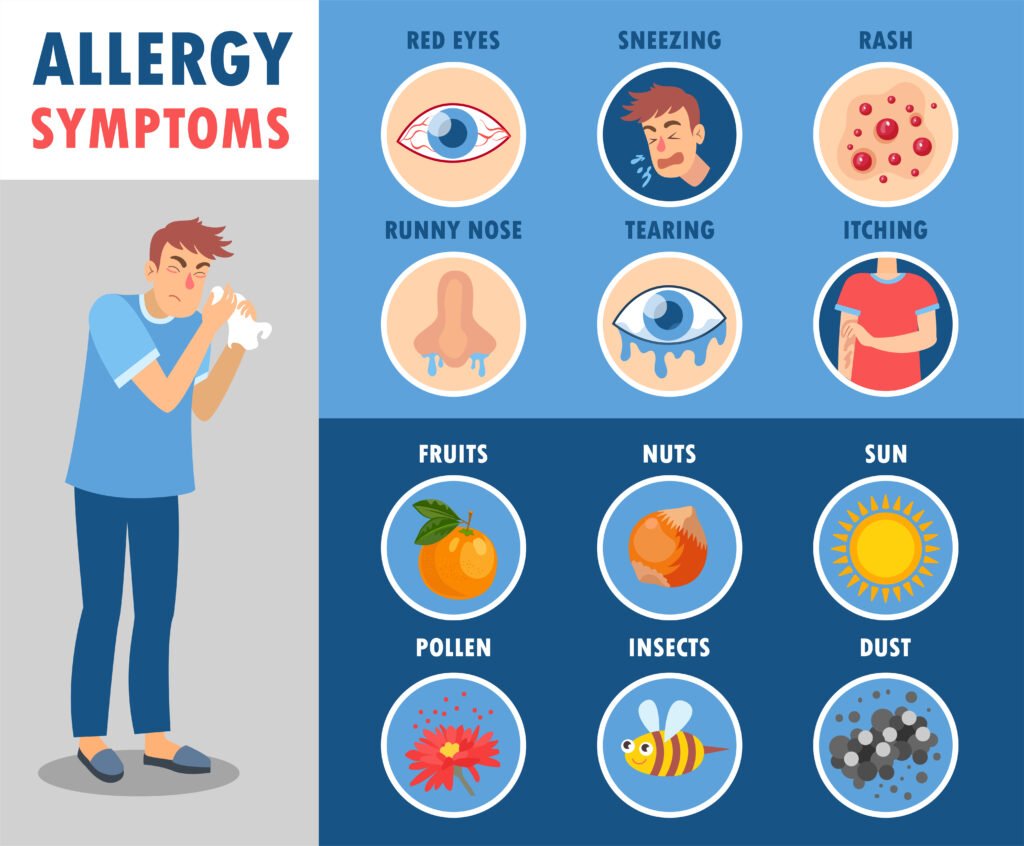Understanding Food Allergies and Intolerances
Despite their interchangeability in conversations, food allergies and food intolerances are separate medical conditions that necessitate different management approaches. Immune reactions characterize food allergies with symptoms ranging from minor skin rash to anaphylaxis. Conversely, food intolerances normally cause digestive problems only and do not trigger the immune system.

Food allergies can present differently such as through skin rashes, respiratory difficulties and gut upsets. These signs indicate profound underlying issues- a body very much resistant to some particular types of foods. For instance, genetic makeup is one aspect that defines who suffers from these diseases while environmental components and personal experiences also play major roles.
Traditional vs. Holistic Approaches to Allergies
Whereas conventional medicine often emphasises allergen avoidance, yoga is an alternative treatment for proper allergy management strategies. This has been said to be successful for people who have practiced techniques like Shambhavi or Shakti Chalana Kriya for many years—even though it usually takes 6-9 months.
Kapalabhati is an example of a yogic practice based on specific way of breathing that holds promise in this regard. By facilitating the movement of life force within the human body through it, practitioners claim that about 60% -70% cases regarding this condition have been successfully resolved through regular practices alone.
Addressing Allergies in Children
The prevalence of food allergies in children has increased over time. Accordingly, cow milk should not be given to children beyond two and half years due to risks associated with mixed animal milk but rather replaced with lentils legumes nuts fruits vegetables which makes them more resilient against illness later on in life.
Lifestyle Choices and Their Impact on Allergies
Adequate dietary adjustments made during childhood promote well-developed health without having to visit doctors frequently.. They show how simple yoga exercises can bring about great changes in an individual’s life.
Yogic Practices for Allergy Management
The management of food allergy through yogic practices is very beneficial. For example, Kapalabhati breath and Shambhavi techniques increase energy flow within the body thereby generating inner calmness and awareness.

Also, practicing these techniques with intention and patience will result to significant improvements over time not only on the allergy symptom but also on general health; it can be seen as a transformation of overall well-being.
Nutritional Adjustments for Children with Allergies
In managing food allergies amongst children, dietary choices must be taken into careful consideration by their parents. The most common allergenic foods include milk, peanuts, tree nuts, shellfish, gluten and soy; these ingredients should be checked out on the labels before any food is bought to avoid hidden components.
Elimination diets are useful tools in this regard as they enable identification of problematic foods while encouraging concentration on safe ones. However, such endeavors ought to be conducted under professional guidance since they should take into account nutrient adequacy. Dietary enhancement includes whole foods such as fruits and vegetables lentils and nuts which help in boosting immune systems besides also reducing chances for getting allergies.
Moreover, plant-based alternatives that are suitable cow’s milk substitutes beyond two years old may include almond oat milk or soymilk. Introducing new foods systematically allows caregivers to monitor reactions effectively while fostering a better understanding of which foods positively impact health.
More than that though incorporating gentle physical activities like yoga will boost overall wellness -an approach which has worked incredibly well with many people in mitigating allergic reaction signs.
Creating a Supportive Environment
Healthy eating involves more than food; it means creating an atmosphere where children are given information about what they eat without being judgmental. Involving the children in meal preparation and shopping for fresh produce makes eating together a positive experience instead of a stressful one.
Managing Allergies in Children: A Comprehensive Approach
The journey towards managing allergies in children is unique; it involves dietary changes, an awareness of allergens and a holistic approach to health.
Healthy futures, which are free from worry about allergies, can be created for families by adhering to whole foods and including yogic practices in their daily routines.
In conclusion, supporting children with allergies requires understanding, adaptability and joy of feeding them. This involves focusing on whole foods, embracing other sources of diet and practicing mindfulness in eating habits. This can make our children healthier by the way we eat through emphasizing on whole food consumption and considering different dietary sources as alternatives to cow’s milk while practicing mindfulness.
Increasingly common child allergies mean being careful about what one eats so as not to trigger them. There are certain types of food that promote a healthy defense system; namely whole foods like fruits, vegetables and non-cow’s milk products. Teaching kids how to choose and prepare meals is a good approach towards successful eating behaviors. Allergy symptoms can be relieved by indulging children in yoga breathing exercises linked with holistic therapy for general well-being purposes.





